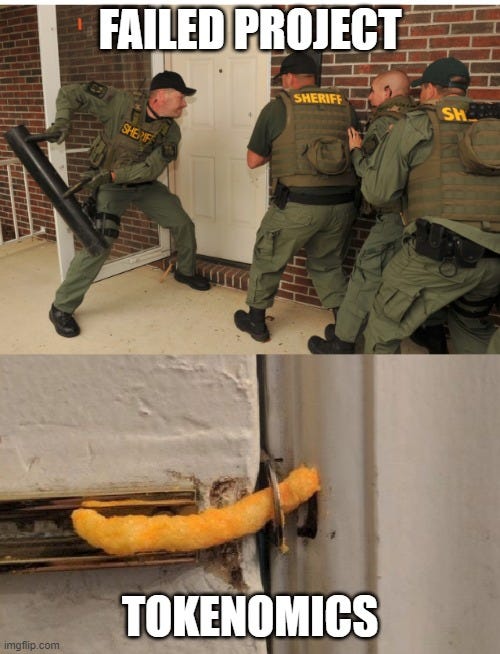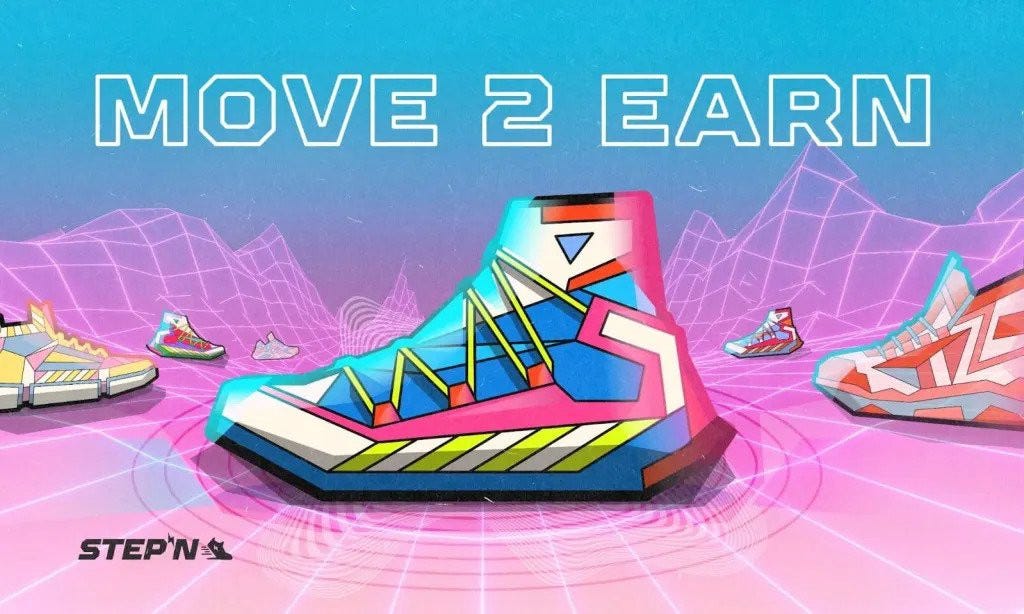This market has me feeling like Hugh Glass, the legendary fur trapper who was mauled by a grizzly bear. Leonardo DiCaprio fans may recall that even after being mutilated and left for dead, Hugh (The Revenant), was able to complete his journey back to Fort Kiowa by surviving on wild berries and roots.
The wild berries in this story are perhaps synonymous with the recent BlackRock news. Momentum within developments has also continued albeit the lackluster reflection in crypto prices as noted by the fact that crypto projects have raised more in the first half of 2022 ($30B) than all of 2021. So, trust the process and stay hard. We will all soon make it back to Fort Kiowa, or perhaps the moon with this DAO.
One of the prominent reasons why blockchain technology is so fascinating is because of the swath of potential use cases and applications that can leverage blockchain. The space has transformed over the years as investors have built a deeper understanding of the technology and token utility. At the height of the ICO boom a team could raise millions of dollars with a scrappy whitepaper and a token issuance. Investors have now matured and reverted to a more fundamental approach – demanding strong founding teams with well thought out roadmaps before participating in rounds – before deploying their shares in the bloated wall of committed capital raised.
As discussed in my previous posts, there are myriad challenges to tackle before getting to mass adoption. Basic infrastructure, which has not proven itself ready for scale, sits at the core of these challenges. This is not too concerning in my opinion. The research, effort, brainpower, and capital that have been invested into this topic alone will eventually reign superior. Widespread enterprise-grade applications and uses of blockchain will follow suit with the advances in security, scalability, and composability of blockchain solutions. The only impetus relative to enterprise adoption of blockchain is timing. Consumer facing blockchain applications paint a more concerning picture.
Consumer Reimagined
It is evident that the current consumer facing crypto business models do not work. Arguments can be made on several vectors to defend the lack of adoption of current consumer facing products: users are priced out, users are not crypto native, lack of security… the list goes on. While I do agree that these common arguments have some merit, I also think that the correlation that these issues have with regards to consumer adoption is grossly overstated.
There are several cheap L1s upon which applications can be built. Users are not priced out of these. No one was Instagram native and knew how to use Instagram before it was launched. 2 billion people learned to use Instagram. Big tech has had its fair share of security exploits – Facebook was hacked in 2018 and 30 million accounts were compromised. 3 billion people continue to use Facebook. The evidence of the broken consumer crypto model is staggering.
Countless teams are working on consumer facing applications:
Audius - platform for uploading, sharing, and listening to music
Ultra - publishing platform and ecosystem for video games and video game content
Illuvium - open-world fantasy battle game
Basic Attention - digital advertising platform designed to fairly reward users for their attention
The list is extensive with evermore teams committing to build out products that promise to capture users by altering legacy methods of interaction. While each of these ideas targets different industries/users (gaming, music, advertising etc.) they all have one thing in common: incentive-based tokenization.
Tokenomics != Business Model
At the heart of the current consumer facing crypto offerings sits a complex network of tokenized incentives. Teams commonly bury ponzinomic structures into business models through loopholes of intricate token burning, minting, inflation, locking, and vesting mechanics that drive the supply and demand curves for each token. Amid the bull market, when the going was good, these models looked promising – a direct byproduct of token appreciation given macroeconomic conditions at the time.
Token appreciation within the bull market was mistaken for an indicator of business model strength. In a neutral market with all else held equal, perhaps I would concur. But once the tides turned and the music stopped, reality set in. Incentive based tokens deflated quickly and users left in flocks, illustrating the obvious – tokens are not parallel with value.
To be clear, there are legitimate tokenomics models. Chainlink, the decentralized oracle network that supports smart contracts, has a legitimate model. The $LINK token is used to compensate Chainlink Node operators for the retrieval of data from external data sources. Chainlink has over 1,000 integrations and DeFi would not be possible without Chainlink data feeds. Projects need data feeds, and the supply and demand equation is simple. Perhaps this is what piqued the interest of legendary ex-Google CEO Eric Schmidt to join Chainlink as a Strategic Advisor. But Chainlink, like most other legitimate projects, is not directly consumer facing.
The answer to the consumer equation has yet to be found within the plethora of experiments. Each cycle will have its own learning points upon which ideas will be tweaked and tried again.
Founders have continued to push the house of cards tokenization model forward with consumer applications. While consumers were the centerpiece of the equation for these applications, as they should be, the strategic implications of fostering that vision were inadequate. Projects mistook complexity for defensibility which continuously shrunk the TAM and discouraged user engagement.
UX is arguably the most important piece of any consumer facing application. Apple built its success upon simple UX. Consumers listen to music because they love their favorite artists. Consumers watch their favorite videos for entertainment. Consumers play games because they are fun and engaging. No one will shy away from free tokens. But consumers do not want to memorize complex supply/demand models, participate in corporate governance, and become macroeconomic statisticians and full-time crypto traders to participate in their favorite activities. Early signals of this reality initially flashed with “Play-to-Earn” (P2E) projects.
Action-to-Earn Models
“Life is good – I just paid for my Trader Joe’s Banana Bread (highly recommend) with some $GMT token that I earned on my walk over to the Trader Joe’s.”
I would not be shocked if this was a legitimate quote on Overheard New York at the climax of the Stepn hype.
In 2021 the “Insert action word” to Earn models took the crypto world by storm. The most well-known amongst these business models is the infamous P2E model after Sky Mavis, the technology company known for its P2E game Axie Infinity, raised $150M at a $3B valuation. At one point the going was so good that people around the world were taking on P2E games as a full-time job. Many variations (Work-to-Earn, Watch-to-Earn, etc.) of this business model naturally blossomed after the initial P2E traction.
Axie Infinity
Gaming has been a focus within Web3 for years. Axie took the concept of gaming and NFTs one step further to create a blockchain-based game in which players purchase NFTs and battle with other players. Players are incentivized to play to earn tokens. Players can also breed their Axies (NFTs) to sell on marketplaces.
The $AXS token is an ERC-20 governance token that allows holders to earn staking rewards, pay for in-game items, and participate in governance. Users also needed to buy several Axies just to participate in Axie. The Axie revenue model consists of a breeding fee for breeding new Axies and a 4.25% fee for transactions within the Axie marketplace (Axies, land, and land items) which funnels into the Axie Community Treasury.
Axie boasted 2.7 million weekly users in November when Bitcoin hovered around its peak of $70k. The $AXS token took a massive hit once new users were no longer succumbed to the FOMO of entering the Axie ecosystem. With no new users forced to purchase Axies to play, artificially propping up the price of $AXS, the onslaught began. Now, with weekly users plummeting to ~300k, the narrative is clear – Axie was built on the façade of unsustainable monetary incentives rather than for organic user engagement.
Stepn
Axie set the stage for an influx of new ideas. Both retail and leading institutional investors were hot on the 2E economy including the likes of Sequoia Capital, the legendary VC. Stepn, the Move-to-Earn (“M2E”) application was the natural predecessor of Axie. Stepn raised $5M in a seed round from Sequoia, Alameda, Solana Ventures, and other leading VCs after Stepn ranked 4th in a Solana Hackathon and sustained an 80% daily retention rate for users in December of 2021, the peak of the bull market.
Like Axie users, Stepn users buy Stepn sneakers (NFTs) to participate in Stepn. Sneakers were priced north of $1,000. The Stepn application tracks users’ outdoor movements based on time and distanced covered and awards tokens to users for their accomplishments. Each sneaker has a set of different advantages, with more expensive sneakers yielding higher rewards, paving the road for a gamified system for users to exploit with their own strategies. Stepn also has a marketplace for users to swap and purchase NFT sneakers with their $GMT tokens.
The $GMT tokenomics are so complex that Stepn released a blog post explaining the intricacies of the token mechanics. Stepn even ironically acknowledges that “everyone is here to make money” in the blog post and later refutes the common criticism that Stepn has an unsustainable ponzinomics model in the same post.
Fold ‘Em
Unfortunately, many consumers in the 2E economy did not pay attention to the lyrics of the song “The Gambler” by Kenny Rogers.
“You've got to know when to hold 'em, know when to fold 'em, know when to walk away, and know when to run. You never count your money, when you're sittin' at the table, there'll be time enough for countin', when the dealin's done”.
The dealin’ was done as soon as the token prices plummeted in the wake of the bear market. Successful consumer facing applications are not correlated with macroeconomic factors. Recession or not, gamers still game, music fanatics still stream their favorite artists, and people still use social media. Successful consumer facing applications thrive because they offer true value in the form of engagement, not artificial token value that is sustained by perverse tokenomics, a model that has continuously been proven ineffective.
PoolTogether: A Case Study
I want to highlight an effective consumer crypto model. PoolTogether is a “no-loss lottery” crypto application built on the concept of premium bonds. At a high level PoolTogether allows users to buy tickets to enter a lottery. The capital raised from the lottery tickets is locked into DeFi protocols (Yearn, Compound, Curv, etc.). The yield generated within the DeFi protocols is then distributed to the lottery winners every week. The principal raised from the ticket sales is liquid and is never distributed to winners. Lottery tickets are thus redeemable for their initial principal at any time, hence the “no-loss” aspect of this mechanism.
Users reap all the upside correlated with the growth of the PoolTogether community which at one point had $250M of TVL within DeFi, paying out +$200k in weekly prizes. Users are also actively engaged with the compounding treasury and are incentivized to buy more lottery tickets to increase their likelihood of becoming a winner, all while never losing their principal investment.
While I do not think this is the future of consumer for crypto, I do think that the concepts can be leveraged to build this future:
Engaging - rewards are correlated with engagement rather than tokenomics
Real value - real DeFi based rewards (e.g., USDC) rather than segregated ponzinomics
Simple - simple UX and graspable mechanics
The idea that “Every Company Will Be a FinTech Company” has been around for years. This concept is even more momentous within the crypto space. Treasuries for every crypto company will run through DeFi to fund operations and build out engaging consumer models. Tangible incentives funded through DeFi will trump ponzinomic based tokens with substantial supply and dilutive constructs.
Imagine if your favorite FinTech app has a mechanism in which lump sum lottery-based payouts are offered to its users who are incentivized to save more on the application to boost their odds for a major payout. The same could be said for incentives for paying off credit, creating a major flywheel and sticky business model. Or if your favorite RPG game distributes USDC that was yielded through NFT sales invested in DeFi to the most active 10,000 players of the week. I am keen to know what happens next. The possibilities are endless with the right strategy.
Looking Forward
Web3 founders need to take a step back and come to peace with the idea that there is no need to reinvent the wheel by introducing tokenomics models into every idea. Tokenomics is a powerful tool if used correctly. But tokenomics should take a back seat to the concept of engagement. Engagement is the basis of consumer success.
Rather than forcefully marrying engagement to tokenomics, founders and investors should first ask themselves “Would I use this application without the tokenomics incentives?” before making any rash decisions. If the answer is “Yes” then bootstrapping an incentive mechanism may create powerful synergies within a sticky business model.
So, is there a sustainable future for 2E products? Only time will tell. But there is one “to-Earn” business model that has proven itself since its inception and is arguably vital to consumers who are down 90% YTD on their portfolios. W2E. Work-to-Earn is back baby.
I am always open to connecting with others to learn about new companies within the web3/fintech space. Please feel free to reach out here!










I've had these exact same thoughts, just wasn't able to formulate them as well. Great article.